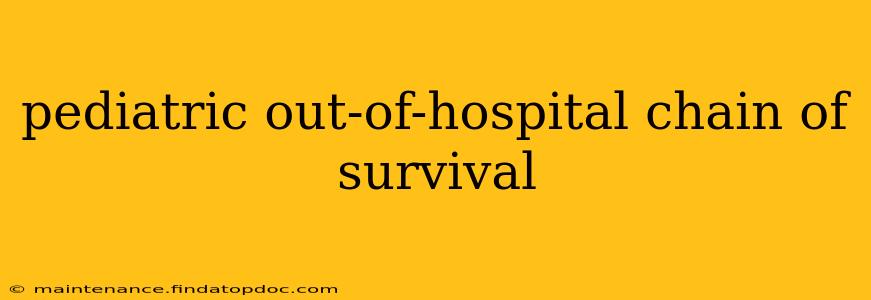The out-of-hospital chain of survival for children differs significantly from that of adults, emphasizing the crucial role of early recognition and immediate action. A child's smaller size, developing physiology, and different causes of cardiac arrest necessitate a tailored approach to maximize survival rates. This article will delve into the key links in this chain, addressing common questions and providing vital information for parents, caregivers, and healthcare professionals.
What are the links in the pediatric chain of survival?
The pediatric chain of survival highlights five crucial links:
-
Immediate Recognition of Cardiac Arrest and Activation of the Emergency Response System: Recognizing the signs of cardiac arrest in a child is paramount. This includes unresponsiveness, absence of breathing or only gasping breaths, and no pulse. Immediate calling of emergency medical services (EMS) is crucial, as prompt intervention significantly improves survival chances. Don't waste time attempting advanced life support before calling for help.
-
Early CPR: High-quality cardiopulmonary resuscitation (CPR) is essential. Chest compressions should be performed with appropriate depth and rate, tailored to the child's age and size. Early CPR helps maintain blood flow to the vital organs until professional help arrives.
-
Rapid Defibrillation: While less frequent than in adults, defibrillation may be needed for children experiencing sudden cardiac arrest. Rapid access to an automated external defibrillator (AED) and its prompt use can significantly increase survival rates. Many AEDs have pediatric pads available.
-
Effective Advanced Life Support: Advanced life support (ALS) provided by trained paramedics and emergency medical technicians involves administering medications, advanced airway management techniques, and other interventions to support the child's vital functions. Their expertise is vital in stabilizing the child's condition.
-
Integrated Post-Cardiac Arrest Care: This final link encompasses comprehensive care after resuscitation, including effective hospital treatment, therapeutic hypothermia (cooling the body), and ongoing rehabilitation. This coordinated approach helps optimize neurological recovery and improve long-term outcomes.
What are the most common causes of cardiac arrest in children?
The most common causes of cardiac arrest in children differ from adults. They frequently stem from respiratory causes such as:
- Suffocation: Choking on food or foreign objects is a major concern.
- Near-drowning: Lack of oxygen from near-drowning events leads to cardiac arrest.
- Severe respiratory infections: Infections like pneumonia can severely compromise breathing and lead to cardiac arrest.
- Sepsis: This life-threatening complication of an infection can lead to circulatory collapse.
- Congenital heart defects: In some cases, underlying heart conditions can contribute to cardiac arrest.
How is pediatric CPR different from adult CPR?
Pediatric CPR differs from adult CPR primarily in the compression-to-ventilation ratio and the technique used for chest compressions. For infants and children, the emphasis is on chest compressions, with a higher compression rate and a two-rescuer ratio of 15:2 (chest compressions to breaths). The depth of compressions and hand placement also differ depending on the age of the child. Always use age-appropriate techniques and resources such as online videos demonstrating proper pediatric CPR.
What should I do if I witness a child in cardiac arrest?
If you witness a child in cardiac arrest:
- Check for responsiveness: Gently shake the child and call their name.
- Call for help immediately: Dial your local emergency number (911 in the US).
- Start CPR: Begin chest compressions at the appropriate depth and rate for the child's age.
- Use an AED if available: Follow the AED prompts.
- Continue CPR until help arrives: Do not stop until emergency personnel take over.
What are the signs of cardiac arrest in a child?
Signs of cardiac arrest in a child include:
- Unresponsiveness: The child is not awake or alert.
- Absence of normal breathing: The child is not breathing normally or is only gasping.
- Absence of a pulse: You cannot feel a pulse in the carotid artery (neck) or femoral artery (groin).
By understanding and implementing the links in the pediatric chain of survival, we can significantly increase the chances of survival for children experiencing cardiac arrest. Early recognition, immediate action, and coordinated care are crucial elements in improving outcomes. Regular CPR training is highly recommended for parents, caregivers, and anyone working with children.
